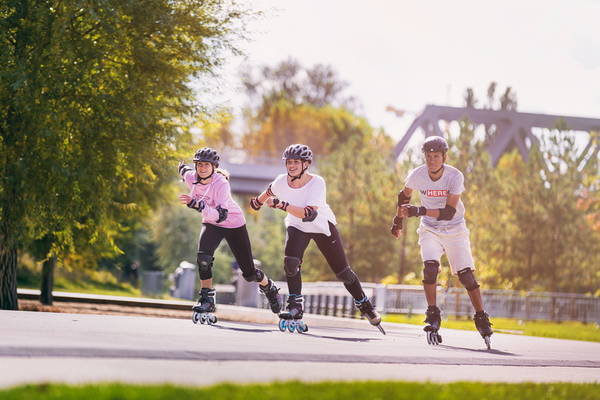Inline Skating - Basic Techniques

Proper inline skating technique is about developing a stable stance on the skates, learning to stop, turning smoothly, and knowing how to fall safely. In this guide, you will learn everything you need to know about inline skating technique as a beginner.
Inline skating is for everyone – big or small, young or old. You need nothing more than a pair of inline skates, some protective equipment, and a smooth surface undisturbed by traffic, and you are ready to start practicing. The learning curve can be steep at the very beginning, but you will see progress after just a few hours of practice, so don’t give up!
Inline Skates Stance
To stand properly on your inline skates, you need to bend your knees. Bending your knees when inline skating gets you closer to the ground, making it easier to balance.
When inline skating, your feet should be parallel, pointing forwards and not inwards or outwards.
With bent knees, parallel feet, and a slightly forward-leaning upper body, your stance should be stable and balanced.
See our how-to video, How to Skate on Inline Skates:
How to Stop on Inline Skates
You can either use the brake pad or the T-stop technique to brake on inline skates. Both techniques are explained in our video guide, How to Stop on Inline Skates:
Using the Brake Pad on Inline Skates
To brake with your brake pad, you move the skate with the brake pad forward, and lift your toes so that the brake pad touches the ground, causing you to slow down. Using the brake pad, you can comfortably adjust the speed with which you roll, or you can use it to slow down completely. As a novice, it is recommended that you get acquainted with the brake pad to stay in control.
T-Stop Technique on Inline Skates
The T-stop technique involves putting one foot behind you and dragging the wheels along the ground perpendicular to the other foot, forming a T. You can drag the wheels until you reach a full stop. To perform a T-stop, you need to be able to balance on one foot while rolling.
T-stops on inline skates allow you to brake using your wheels with no brake pad required. Being able to brake without a brake pad is a huge advantage since brake pads sometimes get in the way. For beginners, getting acquainted with the T-stop is also a great idea since it helps to gain control of what you are doing on your inline skates.
How to Turn on Inline Skates
When turning on inline skates, you should have a slight forward lean with bent knees. If you want to turn left, move your left foot slightly forward, and do the opposite if you want to turn right. Shift your weight to the side that you want to turn to while leaning into the turn with the upper body. Looking in the direction that you are turning towards can be a significant help.
Paying attention to your turning technique can help you to avoid common beginners’ mistakes, and it will be an advantage for learning the cross-over turning technique which you will be learning as you progress.
Falling Safely on Inline Skates
Falling forward is always preferable because this allows you to control the fall, and not hit the back of your head or your tailbone against the ground.
If you are about to lose your balance on inline skates, do the following:
- Crouch and lean forward – staying low keeps you closer to the ground, minimizing the impact from falling. Maybe you will even be able to regain control.
- Use protectors to take the fall – If you fall on your knee pads, elbow pads, or wrist pads, they will take the impact, rather than you. If you are rolling at a high pace when falling, try to slide on your protectors when you fall to avoid abrasions.
With these techniques, you will be less likely to suffer injuries that could interfere with your progression on inline skates.
Finding the Best Inline Skates to Learn On
Beginners as well as more advanced inline skaters should always look to get inline skates that fit snugly and feel comfortable. Inline skates for beginners should feature a heel brake and offer good ankle support. The wheels should be soft (76A - 84 A) and not be too large – 84 mm or less for adults with large feet, and for children a proper size falls somewhere below 70 mm.
Check out our guides on buying inline skates for more information:
